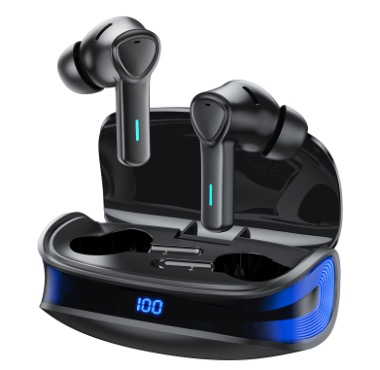In the sonic realm, where wired and unwieldy equipment once ruled, a new wireless champion has emerged: Bluetooth earphones. These wireless devices, shrouded in the seductive mystery of wireless technology, provide excellent audio quality that equals their conventional counterparts.
This article delves into the heart of Bluetooth earphones and the enigmatic components known as speakers or drivers. It will also tackle the unravels of the science behind these microscopic marvels of audio technology. We’ll venture into their inner workings, evolution, and their role in enhancing our daily audio experience.
The Core Components: Understanding Bluetooth Earphone Speakers and Drivers
Bluetooth earphone speakers, often called drivers, are the vital components that convert electrical signals into sounds we can hear. We’ll explore the magic behind this transduction process, the different types of drivers, and how they affect the sound quality of your favorite tunes.
The Transduction Process
Transduction is a speaker or driver’s main function. The journey begins when your earphone receives a Bluetooth signal from your smartphone, PC, or music player. This signal is an encoded version of the original sound source, which your earphone decodes into an electrical signal.
The driver sends the signal to the voice coil, a vital component wrapped around a small magnet. An electrical signal creates a magnetic field in the voice coil and diaphragm. These vibrations move air around the diaphragm, creating sound waves that enter your ear.
Different Types of Drivers
The quality and character of sound produced by earphones are heavily influenced by the type of drivers they employ. Here are a few common types:
- Dynamic drivers: Also known as moving coil drivers, they are the most common type found in earphones. They create sound through a magnetic field that moves a coil and diaphragm, offering robust bass and general sound clarity.
- Balanced armature drivers: Smaller and more sophisticated than dynamic drivers, balanced armature drivers use an armature inside a coil to produce sound. They offer more precision and can be tuned to specific frequency ranges, although they may lack bass compared to dynamic drivers.
- Planar magnetic drivers: They are a rare choice for earphones due to their size, but they provide exceptional sound clarity and responsiveness when used. They operate through a thin diaphragm suspended between two magnetic fields.
- Electrostatic drivers: These are even rarer and more expensive than planar magnetic drivers but offer unparalleled sound detail and accuracy. They work by moving a thin diaphragm between two electrically charged plates.
The Impact on Sound Quality
The type of driver used greatly influences an earphone’s sound, affecting bass depth, clarity, and frequency response. Dynamic drivers offer versatile sound performance across genres, while balanced armature drivers, commonly in premium earphones, provide unparalleled precision, favored by audiophiles for their sound detail and fidelity.
The Evolution of Wireless: From Bulky Headsets to Sleek Earbuds
Journey with us through time as we chronicle the development of Bluetooth earphones, from the first bulky headsets to the sleek, compact earbuds of today. We’ll analyze the technological advancements that have miniaturized these devices and significantly boosted their performance.
The Dawn of Wireless Audio
In the annals of wireless audio, Ericsson’s first significant entry was the creation of Bluetooth technology in 1994. The intent was to develop a wireless headset for mobile calls. However, the technology didn’t gain mainstream popularity until the late 1990s and early 2000s, when the first generation of Bluetooth headsets hit the market. These early headsets were anything but sleek, often large, cumbersome devices with short battery lives and spotty connections.
Enter: The Earbud Era
Bluetooth earbuds’ miniaturization began in the mid-2000s, with smaller, neckband-connected models offering improved comfort and stability. However, the true revolution came with Apple’s completely wireless AirPods in 2016, thanks to advancements in Bluetooth and battery technologies and the further miniaturization of audio drivers.
The Era of Sleek, Compact Earbuds
Today’s Bluetooth earbuds are compact yet technologically advanced, housing sophisticated drivers, microphones, batteries, and often touch controls. They offer features like noise cancellation, adaptive EQs, and fitness tracking, surpassing early Bluetooth audio capabilities. Improved battery life allows for hours of playback with additional charges from the carrying case.
The Journey Continues
The journey from bulky headsets to sleek earbuds is a testament to the relentless pace of technological innovation. With each passing year, Bluetooth earphones become smaller, more powerful, and packed with more features, proving that evolution is the only constant when it comes to technology.
The Role of Bluetooth Earphone Drivers in Your Daily Audio Experience
Earphone drivers are not just for music enthusiasts. They shape our daily audio experiences in numerous ways, whether during a conference call, a morning jog, or an immersive movie session. We’ll explain how understanding your earphone drivers can help optimize these experiences.
Guiding Your Morning Run: Music on the Move
Bluetooth earphone drivers play an indispensable role in elevating our workout routines. Whether it’s the energizing beats that fuel your morning run or the soothing melodies that aid your yoga practice, the sound quality delivered by your earphone drivers can make or break your exercise experience. For instance, dynamic drivers in your earphones can provide the rich bass and clear treble needed to create a motivating soundtrack for your workouts.
Setting the Tone for Your Conference Calls: Clarity in Communication
In the era of remote work and virtual meetings, Bluetooth earphones have emerged as critical tools for clear communication. The drivers in your earphones ensure that every word, every nuance in tone, is captured and delivered with clarity, fostering effective collaboration. High-quality drivers can help reduce background noise and maintain consistent audio output, thus avoiding the dreaded “Can you repeat that?” during important conference calls.
Immersive Movie Sessions: Bringing the Theater Home
The advent of Bluetooth earphones has transformed movie watching at home. With balanced armature drivers offering a wide frequency range and detailed sound, or even hybrid models using a combination of dynamic and balanced armature drivers, you can experience an immersive cinematic soundscape in your living room. From the faintest whisper to the most explosive action sequences, earphone drivers play a crucial role in delivering an immersive audio experience.
Personalizing Your Audio Experience
Understanding your earphone drivers also allows for a more personalized audio experience. For example, if you’re a bass lover, earphones with larger dynamic drivers could be your best bet. If you crave precision and balance in your music, then earphones equipped with balanced armature drivers might be the right choice.
In essence, drivers are the hardworking heroes behind the sound in our Bluetooth earphones. Their impact stretches beyond just playing music, touching various aspects of our daily lives. We can make more informed choices and optimize our audio experiences by appreciating their role and understanding their function.
Conclusion
Bluetooth earphone speakers or drivers are the unsung heroes behind the wireless audio devices that accompany us throughout our days. By understanding their role, we gain a deeper appreciation for these compact sound powerhouses, enhancing our listening experience and our relationship with technology.
As we keep pace with the evolution of Bluetooth earphones, we anticipate an exciting future where our auditory experiences will become increasingly immersive and personalized. The wireless sound age is just starting, and we’re all ears for what’s to come.


